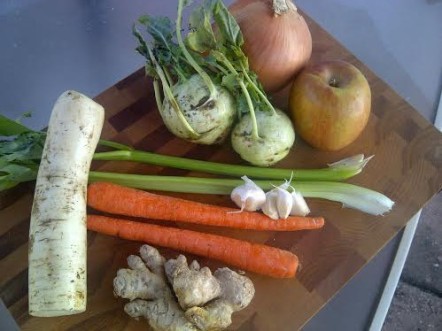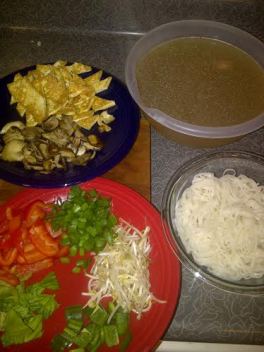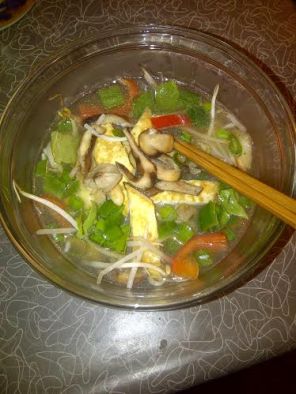One of the main commonalities of the Blue Zones is that vegetables make up a significant percentage of their resident’s diet. While I am in NO WAY ready to make the leap into becoming a vegetarian, one of my goals is to limit my intake of meats (including fish) to a handful of meals per week. I’ll need to consume meat often enough to where it does not ‘interrupt’ my digestive process every time I eat it, but still keep it minimal enough to allow for healthier options.
Vegetarian Pho (Pho Chay)
Reply
I’m 99.78% certain that tonight (Friday) is going to involve the consumption of copious amounts of alcohol, accompanied by a case of the late-night munchies, and as Sarasota, FL, is not necessarily known for its late night vegetarian chow-houses, I decided to skip the meat last night.
Pho Chay (simply, pho with a vegetable-based stock and with no meat toppings) is something I have wanted to make for a while now. I looked at a couple of recipes, but could not settle on one that made me want to fire up the burner. So, I took a few basic concepts, headed to the market, and had fun with it (essential to cooking!).
Here is what I came away with:
First, the broth for the pho chay~
2 kohlrabi bulbs, peeled and rough chopped
1 yellow onion, cut into eighths with skins left on
4 cloves of garlic, smashed and peeled
2 carrots, washed and rough chopped
2 stalks of celery, washed and rough chopped (get rid of the leaves as they are too bitter for the broth)
1 dacon radish, peeled and rough chopped
2 knobs of ginger, washed and rough chopped
1 fuji apple, cut into eighths with core removed
2 sticks cinnamon
1 tbsp star anise seed (placed in a tea bag and tied shut with twine)
2 tsp ground cardamom
8-10 cloves
1 tbsp sea salt
fresh cracked black pepper to taste
14 cups cold water
Pre-heat your oven to 450-500 degrees. Take the above ingredients and spread them around in an oven-safe pan or tray (at least a 2″ rim), drizzle with about 1 tbsp of EVOO (extra virgin olive oil), toss to coat evenly, and place in the oven. What you are looking for here is to start the aroma, to start the release of the juices / oils, and to get a little bit of color. Keep them on the top rack and check them every 8-10 minutes to ensure that you are not getting any burning / charring. The reason I chose to roast the vegetables rather than dropping them directly into the pot is that, due to the fact that this pho has had the typical beef bones / ox tail eliminated from the broth making process, we want a little bit of color as well as a little more depth of flavor. Roasting helps to ‘deepen’ your vegetables.
While the magic is happening in the oven, get two cinnamon sticks, 2 tsp of ground cardamom, 8-10 cloves, and 1 tbsp of anise seed (place these in a tea bag or you’ll end up picking them out of your teeth later) and set aside.
Once you feel your work in the oven is done (there is no set time because all ovens are slightly different, so follow to what your eyes and your nose are telling you), take your tray out of the oven and dump the contents into a large stock pot. VERY IMPORTANT: take the now empty and still hot pan or tray over to the sink and run about a cup of water into it. Then, take a wooden spoon and gently scrape (deglaze) all of the brown bits (fond) and oils off of the bottom and the sides of your tray. You will see how dark and rich the water becomes as you do this. Once your pan / tray is deglazed, take the gold you’ve just created and drop it right into your pot. Follow that with the spices that you set aside, plus one large tbsp of sea salt and a few twists of fresh cracked black pepper. Then, fill the pot with 14 cups of cold water. Bring this to the cusp of boiling, then drop it down to simmer and keep the bubbles coming on the slow and gentle side for about 50-60 minutes, stirring every 15-20 minutes.
Second, the toppings for your pho chay~
12oz package of extra firm tofu (pressed or un-pressed)
6-8 shiitake mushrooms
6-8 baby portobello mushrooms
1 jalapeno, chopped into bite-sized pieces
1 bag of your favorite bean sprouts
1 red bell pepper, chopped into bite-sized pieces
1/2 bunch of green onions, fine chopped
6 medium / large basil leaves, rough chopped
1 box of your preferred rice noodles
salt / pepper
Now, take your favorite tofu (or, if you are brand new to this whole tofu thing, a 12oz block of extra-firm tofu) and cut it into slabs about 1/4″ thick. Heat 1 tbsp EVOO in a large pan over medium heat, and pan-fry the tofu until golden brown on both sides. Browning time will depend on moisture content. Remove from heat, and cut into bite-size pieces, then hit them with a pinch of salt and pepper.
Clean your pan, then heat another 1 tbsp of EVOO over med-low to medium heat. To the pan, add you favorite mushrooms. I went with shiitake and baby portobellos. Saute these until lightly browned, hitting with salt and pepper about a minute after they hit the pan. You want to keep the heat relatively low, because you want the mushrooms to be cooked, but also to remain meaty. Don’t over cook! Once done, place mushrooms on a paper towel to get any extra EVOO off the finished product.
Set the mushrooms and tofu aside for now.
Bring a pot of salted water to a boil (volume of water per the instructions for your selected rice noodles). While that process is under way, prepare the balance of your toppings. This phase is really up to personal preference. We went with a jalapeno, basil, bean sprouts, green onion, and a red bell pepper. The only real key here is, whatever toppings you choose, keep them bite-sized.
Once your water boils, drop the noodles and cook to preference; for us this means slightly al dente. Once ready, strain the noodles and rinse with cold water to prevent sticking. Set aside. Now, strain your broth into a large bowl. I prefer lining a colander with cheese cloth to remove the tiny bits. Remove the vegetables from your stock pot, return the broth to the pot, and return to the pot to the burner on low heat.
At last, we assemble. Grab a bowl (the deeper the better), place a serving of rice noodles in the bowl, assemble your desired amount of tofu and mushrooms on top of the noodles, then, sprinkle on whatever other toppings you’ve selected. To finish, ladle your broth onto the contents of your bowl. Keep in mind that the broth is what is going to heat (or reheat) your other ingredients, so use enough to make your toppings swim. Grab your chopsticks, a spoon, and enjoy!
This was a lot of fun to make! There are so many options as far as what you can do with toppings that you can practically have a new product each time you make it, even when reusing the same broth recipe. That said, I recommend you make yourself a large pot of the broth, strain it, put it in containers and freeze it. You’ve now cut that hour off of your next pho chay craving; just heat up your broth!
Nutrition:
The only thing you need to watch here is how much EVOO you use to saute with. Oil is fat, and while fat is usually flavor, part of this for me is finding the flavor in your other ingredients and not relying on the fat to sum up your dish. EVOO loses much of its heart-health benefits once it’s heated, so be easy with how much you use here.
Vegetable stock or broth does not provide you with much in the way of vitamins, but it does usually contain much less fat that meat-based broths. Also, making your own vegetable broth, as we did here, allows you to control the amount of sodium in the finished product, which is typically the biggest concern with store-bought products. Also, if you are trying to limit your use of canned products, you may want to have broth / stock making become a regular activity. (Also, it makes your whole house smell amazing!)
If you have any questions or comments, don’t forget to contact me. I’d love to hear your feedback if you decide to try a bowl of this pho chay!
ENJOY!





